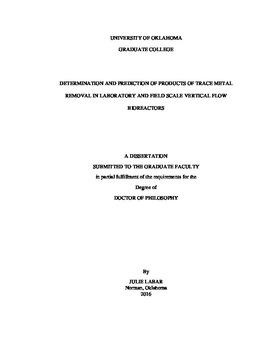| dc.description.abstract | Mine drainage is characterized by elevated concentrations of dissolved iron, sulfate, and trace metals and generally exhibits an acidic pH. These constituents, particularly trace metals, can pose serious risks to both environmental and human health and require some sort of treatment. Passive treatment systems (PTS) have become a common technology used in the treatment of mine drainage. A component of these systems, vertical flow bioreactors (VFBR), may be used to remove trace metals through a variety of mechanisms, resulting in different removal products.
Ionic strength is a measure of dissolved ions in solution and correlates strongly with total dissolved solids (TDS) concentrations and conductivity. In mine drainages, ionic strength is commonly dominated by the sulfate anion and various cations, including calcium, magnesium, iron, and occasionally sodium. Large concentrations of these constituents may impact trace metal removal processes in VFBR, including sulfide precipitation, adsorption to and complexation with organic matter, and carbonate precipitation by impacting solubility and availability.
The premises of this dissertation are that trace metals are removed from mine drainage through a variety of mechanisms in vertical flow bioreactors, that ionic strength has an impact on which mechanisms play a dominant role in trace metal removal, and that geochemical modeling can be used to predict how trace metals will be retained in VFBR. Three studies, resulting in four chapters, were performed to evaluate these ideas.
Chapters One and Two describe the results of the first study, which evaluated ionic strength impacts on trace metal removal in VFBR. Chapter One, “Evaluation of the impact of Na-SO4 dominated ionic strength on effluent water quality in bench-scale vertical flow bioreactors using spent mushroom compost” specifically addresses the effects on water quality as a result of elevated ionic strength, whereas Chapter Two, “Evaluating the impact of Na-SO4 dominated ionic strength on trace metal removal products in bench-scale vertical flow bioreactors using sequential extractions, acid-volatile sulfide analyses, and mineralogical methods” addresses the effects of ionic strength on the products of trace metal removal. Elevated ionic strength appeared to have significant impacts on pH, alkalinity, and trace metal removal. Elevated ionic strength had differing effects on the five trace metals examined, with an increase in ionic strength increasing the rate of removal of Cd and Zn and decreasing the rate of removal of Ni and Mn. Despite the differences observed in effluent concentrations between different ionic strengths, there were no significant differences in total metals concentrations in the associated substrates. Elevated ionic strength resulted in less Cd being retained as an insoluble sulfide, while the opposite was true for Pb. In addition, increased ionic strength caused a decrease in the amount of Pb retained in the labile organic fraction. The ratio of simultaneously extracted metals to acid-volatile sulfides (SEM/AVS) indicated that a large portion of Cd, Mn, Ni, Pb, Zn was likely in soluble and bioavailable forms. When all of the removal products are considered, Ni retention within the substrate was the most stable and Mn was the least stable of the trace metals examined.
Chapter Three, “Characterization of mine drainage vertical flow bioreactor substrates using sequential extractions, acid-volatile sulfide analyses, and scanning electron microscopy,” examined products of trace metal removal in a field-scale VFBR. Water quality data collected at a VFBR in the Tar Creek Superfund Site in northeastern Oklahoma indicate significant removal of trace metals from the mine drainage. Spent substrate samples from the VFBR were collected after 5.5 years of system operation. Results of a sequential extraction procedure (SEP) showed that the vast majority of Cd, Co, Fe, Ni, Pb, and Zn were retained in the VFBR as insoluble sulfides. Subsequent acid-volatile sulfide/simultaneously extracted metals (AVS-SEM) analyses confirmed the retention of Cd, Fe, Pb, and Zn as sulfides, but Co and Ni results were less certain due to the lack of solubility of Co- and Ni- sulfides in cold, dilute hydrochloric acid. With the exception of Mn, trace metals were retained as insoluble products in the VFBR.
Results presented in Chapters One, Two, and Three were used to perform a geochemical modeling study, the results of which are described in Chapter Four, “Using reactive transport modeling to predict trace metal removal products in vertical flow bioreactors.” Water quality data and SEP results from the experimental VFBR described in the first two chapters were used to construct and calibrate a reactive transport model in PHREEQC, which was then validated with data from the third chapter and samples from a third party. The model results provided fair predictions of VFBR effluent quality. Predictions of trace metal removal products were upheld by SEP results, with the exception of the labile organic fraction, which was generally underpredicted. | en_US |
